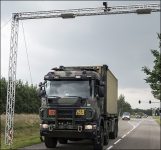
Tonnjes, Kirpestein and NXP completed a one-year on-site vehicle identification test
[ad_1]
Vehicle registration and identification technology company Tonnjes, license plate manufacturer Kirpestein BV, and RFID chip manufacturer NXP Semiconductors completed an experimental project that proved that passive UHF RFID license plates can effectively identify moving vehicles in the harshest environments. The three companies tested the technology in Dutch military bases by reading the license plates of various high-speed military vehicles.
The test lasts for one year to determine whether the European vehicle registration agency can deploy metal license plates with built-in RFID tags. In the one-year field test, the company used IDePLATE and IDeSTIX RFID tags provided by Tonnjes, and built-in NXP’s UCODE DNA UHF RFID chip. Tonnjes also provides integrated software to manage the data read by the reader and automatic camera. During the test, Kirpestein used the IDePLATE specification to integrate the UCODE DNA chip into the license plate. The 100 vehicles in the test used IDePLATE license plates, which can be attached to IDeSTIX RFID stickers on the windshield.

(2 Kathrein RRU4-ELC-E6-KRAI readers, 4 Kathrein WiRa-30 antennas and 1 digital camera are installed on the OTCRij road mast)
Olaf Renz, managing director of Tonnjes, said that the system reading success rate based on RFID and camera has reached 98%.
Renz said that IDePLATE license plates and IDeSTIX windshield tags are designed to improve the safety and reliability of government vehicle registrations. This kind of data helps the organization determine whether the vehicle license plate is forged. Since each license plate and windshield tag requires RFID technology to read and compare, this technology makes license plate forgery more and more difficult.
In addition, law enforcement officials can also use the technology to identify vehicles that are speeding or running red lights. Transportation authorities can also use this technology to charge fees.
Experiments have proved that passive RFID technology can work in harsh environments.
The field test was conducted at the training facility of the Dutch Ministry of Defense in Oirschot. Each military vehicle was equipped with 2 IDePLATEs, one installed on the front wheel and the other on the rear wheel. In addition, IDeSTIX RFID stickers are installed on the windshield. OTCRij has various types of vehicles, from motorcycles to main battle tanks, which is why the venue was selected.
Two Kathrein RRU4-ELC-E6-KRAI readers, four Kathrein WiRa-30 antennas and a digital camera are installed on the OTCRij road mast. Renz said: “We use an IP camera developed for ANPR applications. In addition to special technical features-such as automatic image capture during the day and night-OCR software has become the most important part of the ANPR system.” Reader reads After decrypting the label data, the data and license plate image will be transmitted to the Tonnjes software.
Many military vehicles have additional metal coatings, which is also a disadvantage for passive RFID tags. The biggest challenge of this project is to ensure the identification reliability of IDePLATE and IDeSTIX tags.
Maurice Geraets, managing director of NXP Netherlands, said the UCODE DNA chip provides security, which transmits its unique identifier after the reader sends a signal. He said: “Only when the reader is authorized to read, the chip will send an encrypted unique identifier to the reader. At the same time, the UCODE DNA chip can also bring low power consumption.”
During the initial test of 60 vehicles, it was found that 35 vehicles were recognized by ANPR cameras and 49 vehicles were only read by RFID readers. At a speed of 150 kilometers per hour, the tag reading rate is as high as 98.3%.
At present, several government agencies in South America will also test the technology. Tonnjes is currently deploying systems using IDePLATE and IDeSTIX RFID tags in the Cayman Islands and Honduras. In addition, Peru has used 2 million IDeSTIX tags for vehicle registration.
[ad_2]



